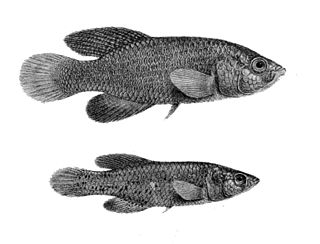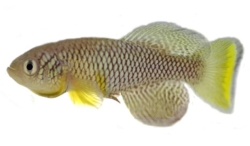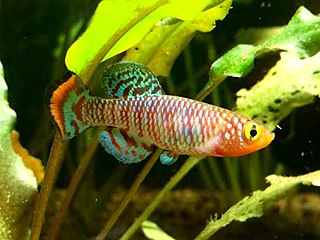
Nothobranchius is a genus of small, freshwater killifish, classified in the family Nothobranchiidae in the order Cyprinodontiformes. There are about a hundred species in the genus, many with very small distributions. They are primarily native to East Africa from Sudan to northern South Africa, whereas a dozen species are found in the upper Congo River Basin; the greatest species richness is in Tanzania.

The orchid nothobranch is a species of killifish in the family Nothobranchiidae. It is endemic to the lower basin of the Rufiji River in Tanzania. Its natural habitat is temporary pools and swamps. This species is found in both a blue and red form. This species was described in 1982 by Lothar Seegers with the type biology given as the Rufiji River near Utete, Rufiji District of Pwani Region in Tanzania. The specific name honours Seegers companion on two expeditions, the German aquarist Gerd Eggers.
Nothobranchius foerschi is a species of killifish in the family Nothobranchiidae. It is endemic to Tanzania. Its natural habitat is probably temporary pools. The specific name honours the German physician and aquaris Walter Foersch (1932-1993), who was an expert in killifish and was one of the first people to keep and breed this species.
The redtail notho is a species of killifish in the family Nothobranchiidae. It is endemic to Zanzibar. Its natural habitats are intermittent rivers and intermittent freshwater marshes. The redtail notho eats mosquito larvae and other planktonic creatures. Scientists are looking at introducing the species elsewhere in Africa to help with malaria prevention.
Nothobranchius janpapi is a species of killifish in the family Nothobranchiidae. It is endemic to the Ruvu and Rufiji rivers in eastern Tanzania. Its natural habitats are small pools and ponds situated on floodplains. The specific name honours the Dutch aquarist Jan Pap, who first discovered this species in 1975 and sent examples back to the Netherlands.
Nothobranchius jubbi is a species of killifish in the family Nothobranchiidae. It occurs in north eastern Africa in Kenya, Somalia and Ethiopia in temporary pools, ditches, marshes and rain pans, normally ones without any connections to rivers. This species was described in 1979 by Rudolf Hans Wildekamp and Heinz Otto Berkenkamp with the type locality given as a pool on the road to Garsen, 17 miles north of Malindi. The specific name honours the South African meteorologist and ichthyologist Reginald A. “Rex” Jubb (1905-1987) of the Freshwater Fish Section at the Albany Museum in Grahamstown, South Africa, in recognition of his taxonomic work on the genus Nothobranchius.
Nothobranchius kirki, the redfin notho, is a species of killifish from the family Nothobranchiidae which is endemic to Malawi where it occurs in the drainages of Lake Malawi and Lake Chilwa. It inhabits swamps and ephemeral pools. This species can reach a length of 5 centimetres (2.0 in) TL. It can also be found in the aquarium trade. This species was described in 1969 by the South African ichthyologist Rex Jubb from types collected by R. G. Kirk, who was a fish biologist of the Agricultural Research Services part of the Ministry of Natural Resources of Malawi, from a pool adjacent to the Likangala River which forms part of the endorheic basin of Lake Chilwa in Malawi.

Nothobranchius korthausae is a species of killifish in the family Nothobranchiidae. It is endemic to Mafia Island in Tanzania. Its natural habitat is pools, ditches and small streams. The specific name of this species honours the German aquarist Edith Korthaus who collected the type.
Nothobranchius lourensi is a species of fish in the family Nothobranchiidae. It is known only from the floodplain of the Ruvu River in eastern Tanzania where it is found in temporary pools, where the type was originally collected by Jan Lourens, a biologist with the United Nations Development Programme in Dar es Salaam and who is honoured in its specific name.
Nothobranchius luekei is a species of killifish in the family Nothobranchiidae. It is endemic to Tanzania. Its natural habitat is temporary pools. Its specific name honours the German aquarist Karl Heinz Lüke who was the first person to breed this species in an aquarium.
Nothobranchius neumanni is a species of killifish in the family Nothobranchiidae. It is endemic to Tanzania. It occurs in both perennial and seasonal wetlands including rivers, lakes and ponds where it most likely feeds on planktonic crustaceans. This species was described as Fundulus neumanni by Franz Hilgendorf in 1905. The specific name honours Hilgendorf's companion on some of his expeditions to Africa, the German ornithologist Oscar Neumann (1867-1946).

The spotted killifish is a small, short lived species of fish, an African rivuline from the family Nothobranchiidae. These fish are native to many isolated freshwater pools located in the savannah depressions of east Africa, specifically Malawi, Mozambique, Zimbabwe, and South Africa. This species of fish occurs in ephemeral waters and killifish eggs can survive long periods of dehydration. The word killifish likely comes from the Dutch kil for kill.

Nothobranchius palmqvisti is a species of killifish in the family Nothobranchiidae. It is found in Kenya and Tanzania. Its natural habitats are swamps and intermittent freshwater marshes. This species was described as Fundulus palmqvisti by Einar Lönnberg in 1907 with the type locality being Tanga in the Usambara Mountains of north eastern Tanzania, the type being collected on the 1905-06 Sjöstedts Kilimandjaro-Meru Expedition. The specific name honours the patron of that expedition, Gustaf Palmqvist.
The blue notho, or Patrizi's notho is a species of killifish in the family Nothobranchiidae. It is found in Kenya and Somalia. Its natural habitat is running water. The males are usually around 5.0 centimetres (2.0 in). In the aquarium the females lay their eggs on bottom peat. This species was described as Fundulus patrizii by Decio Vinciguerra in 1927 with a type locality of the Harenaga swamps, near mouth of the Juba River in southern Somalia. Vinciguerra gave this fish the specific name of patrizii in honour of the collector of the type Saverio Patrizi Naro Montoro (1902-1957), an Italian explorer, zoologist and speleologist.
Nothobranchius steinforti is a species of killifish in the family Nothobranchiidae. It is endemic to Upper Wami River drainage, Tanzania. Its natural habitat is intermittent freshwater marshes, pools and rice fields. This species was described in 1977 by Rudolf Hans Wildekamp with the type locality given as "8 kilometers from Kimamba, Tanzania". The specific name honours the Dutch aquarist Theo Steinfort who helped collect the type and bred this species in captivity, making it available to other killifish hobbyists.
The Mnanzini nothobranch is a species of killifish in the family Nothobranchiidae. It is endemic to Kenya where it occurs on the floodplains of the lower Tana River system where it is found in temporary waterbodies and connecting streams. The specific name honours the German aquarist Manfred Willert who helped to collect the type and who donated it to Rudolf Hans Wildekamp who describe the species in 1992.

Nothobranchius furzeri, the turquoise killifish, is a species of killifish from the family Nothobranchiidae native to Africa where it is only known from Zimbabwe and Mozambique. This annual killifish inhabits ephemeral pools in semi-arid areas with scarce and erratic precipitations and have adapted to the routine drying of their environment by evolving desiccation-resistant eggs that can remain dormant in the dry mud for one and maybe more years by entering into diapause.

Nothobranchius rachovii, or the bluefin notho, is a species of freshwater annual killifish from Mozambique. It can grow up to 6 cm (2.4"). It is popular among killifish enthusiasts, who raise them from eggs in aquaria.
Nothobranchius ditte is a species of brightly colored seasonal killifish in the family Nothobranchiidae, belonging to the Nothobranchius brieni species complex. It is endemic to freshwater habitats in the south-eastern parts of the Democratic Republic of the Congo. Adult males reach a length of about 40–42 mm, but the females are slightly smaller. The species is a semi-annual killifish. They inhabit ephemeral pools filled by rainwater during the monsoon season, being adapted to the alteration of dry and wet seasons. As with all members of the genus Nothobranchius, they show extreme life-history adaptations: their embryos survive by entering a three or four month long diapause, within eggs that have a very hard chorion and are resistant to desiccation and hypoxia. When the habitats dry up, the adult fish die and the eggs survive encased in the clay during the dry season.
Nothobranchius sainthousei is a species of brightly red- and blue colored seasonal killifish in the family Nothobranchiidae. It is endemic to freshwater habitats in the Chembe district of the Luapula Province in northern Zambia. It was named in honour of Ian Sainthouse, a "renowned breeder and collector of killifish, for his special longstanding dedication to researches on the genus Nothobranchius".








